Scoutmaster Musings
Archives:
2025 - Jan
2023 2022 2021 2020 2019 2018 2017 2016 2015 2014 2013 2012 2011 2010 2009 2008 2007 2006 2005
Gaiters Protect
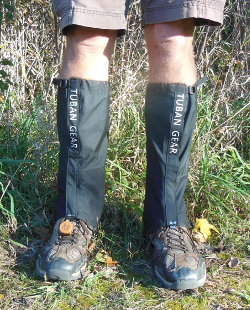

One reason I like taking scouts backpacking up in the mountains above timberline is because I can see forever. Not just the wonderful scenery, but the terrain around me, too. No little animals or snakes rustling in the brush right beside me, no prickly thorns and weeds scratching me, and no roots tripping me while I hike along. Unfortunately, those high mountain hikes are relatively rare since I'm a flatlander and we do most of our hiking through forest, grasslands, and prairies. These are beautiful, but there's a much higher probability of light injury to my lower legs.
A good way to keep lower legs safe, especially for enthusiastic, growing, gangly youth, is to wear a light pair of gaiters. Ankle-high gaiters keep debris out of your shoes as well as a bit of rain, but calf-high gaiters do all that plus provide protection to shins and much more water resistance.
I've owned a pair of gaiters since 1984 - yes, that long! But, I just got a new pair of Tuban Gaiters for free to try and review. They make my old pair (which still work fine) look and feel ancient.
My new gaiters weigh just 2.5 ounces each versus the old 3.5 oz. each so it's easy to forget they are on. They have a strong synthetic instep strap instead of a lace strap so I expect that to withstand abuse from the trail pretty well. A front velcro-type opening replaces my old rear zipper so they are much easier to put on and off. And, the top cinch is a strap and buckle rather than a lace. All in all, a huge improvement in design over a short 30 years. :-)
So, what's the same? Well, they perform their duties just fine. Gaiters are wonderful to keep snow off my pants and out of my boots. Staying dry in cold weather is as important as staying warm. They also help with rain by diverting drips off the shoe instead of letting it soak into the sock and into the shoe. Besides snow and rain, gaiters also stop sand, gravel, twigs, and other trail debris from working its way down to my feet to cause irritation, blisters, and a grumpy mood. Plus, knees down is where most of the trail dirt and grime are accumulated so gaiters help keep scouts and clothes clean on the trail.
Gaiters also provide lower leg protection, specifically against shin scrapes and scratches. While hiking through an old train tunnel doing research for my next book, I hit my leg on a big rock. I was moving my feet slowly and taking my time since I had no flashlight - well, I had one but I was too lazy to get it out for this short tunnel. Oops. No real injury as more than a foot of skin on my shin got peeled off, but it bled and stung for an hour or so and it's just now pretty much healed. A sturdy gaiter would not have prevented me from being stupid about the light, but it would have prevented almost all the damage from that kind of injury.
More common than running into rocks is getting scratched by vegetation. Hiking the 800-mile Arizona Trail, I had my fair share of pokes, scratches, scrapes, and cuts. I was fortunate to not get any cactus injuries, but every plant in the desert is designed to injure whatever comes close to it. One of my water bags even got punctured. Gaiters are perfect protection while hiking in this territory or any place where the trail is narrow or if you have to bushwhack cross country.
The plants and grasses, even those that don't bite, are still irritating in the morning. Hiking the Ice Age Trail, the first couple hours most mornings got my lower legs and shoes soaked just because of the heavy dew and walking through the prairie grass, brush, or whatever was growing along the narrow, less used trail. Gaiters, worn just those first couple hours each day, would have made life much more pleasant.
There are specialty gaiters specifically for snakebite protection and these gaiters are not that kind. Those are heavier, almost like armor. But, even long pants are helpful to prevent snake bites since the snake may hit the fabric instead of your skin. With any gaiter in place, there is a bit more protection.
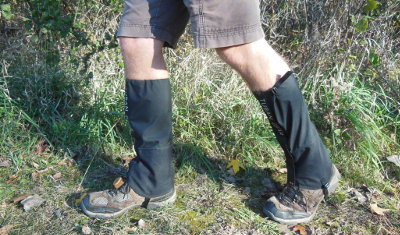

These gaiters are also a good Leave No Trace piece of gear. The synthetic fabric is so tightly woven that burrs, seeds, and other stickers don't cling to it for transportation. You don't wind up being a vehicle for invasive plants to have their seeds dispersed by hitching a ride on your pants or socks, just to be plucked off and thrown to the side to grow at your next rest stop. Also, with the protection from gaiters, you are more prone to stay on the trail instead of straying to avoid any small nuisance in the path.
If you're interested in checking out my gaiters, hike to Amazon and take a look. If you buy a pair, use this code to save 50% ( 2EX3VL22 ) They come in black (my fav), blue (not so much), or orange (hunting season!)
The largest part of my calf is 17 inches around, and 16 inches around just below the knee where the gaiter top rests. The size Large fits fine, but if your legs are larger, go for the size XL. Measure up 18 inches from the floor when standing to find where the gaiter top will be on your leg.
| See 1 comment | Leave Comment |
Posted: 10:30 10-27-2016 1311
One Good Turn


Sometimes a Daily Good Turn takes some effort, and sometimes an opportunity literally blows up in your face.
You've seen the movies where a briefcase full of cash cracks open, or dollars are thrown from a building, or an explosion blasts money through the air, right? Well, this week it happened to me.
After a nice lunch with my family at a restaurant, we were walking down the sidewalk to where our car was parked. My wife and two eagle scout sons were a bit ahead of me. We were walking into a steady headwind. A car had just parked in a spot along the sidewalk and people were getting out as I passed by. The front passenger stepped onto the sidewalk right beside me and closed the door, just as I glanced over in his direction.
As he stepped away on the sidewalk, going the same way I was headed, a fluttering caught my attention in the gutter. A folded stack of dollar bills, certainly more than an inch thick, was unfolding on the pavement and the wind was just starting to flutter off each of the top bills, one by one, sending them scurrying and tumbling along the gutter.
I hollered, "Hey, dude! Wait a minute!" As he looked at me, I pointed to the money. You should have seen the look on his face. He stopped midstride, turned, and bent to pick up the pile - all while saying, "Oh my gosh! Oh no! Oh!"
In the same instant, I changed direction and went to head off the farthest bills before they escaped. They were all $20 bills and there had to be at least 30 of them, probably more. I made sure to keep my hands out in the open in front of me so he wouldn't think I was trying to keep any. We met at his car bumper. I handed him the handful I had gathered and said there was another one way under his car - hey, there's a limit to my good turn doing! He thanked me and I caught up with my family around the corner at our car.
OK, having written it down, it doesn't sound that exciting now. But, I'm glad I had the chance to help someone. If I hadn't been there, he may very well have lost all of it, and whatever it can buy him.
Good Turns are more often not so exciting, but they all make the world a bit better. Keeping an eye open for ways to help others, being aware of your surroundings, and pointing others before yourself are all ways to make finding those opportunities in the world around you.
Scout On
| Leave Comment |
Posted: 22:39 10-26-2016 1310
Lions and Tigers and Bears
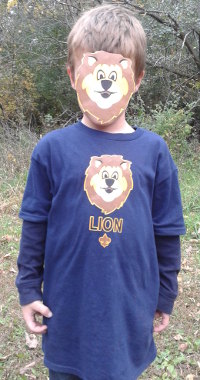

Oh my, it's fun to have all three of those critters part of the Cub Scouting program now. The kindergarten Lion program seems to have been 'in the works' forever since our council has been piloting it for a few years now. Pretty much every pack has been happy with the new, younger members.
I finally met my first real Lion scout out in the wild! At camp this past weekend, a pride of them were rambling through the forest past our training site and I convinced one to slow down enough for a picture. That's what the Lion t-shirt looks like out in its natural habitat.
With the Lion program being piloted in 200 councils starting right now this fall, it's only got some tweaking left to become finalized for next year. I expect there will be some changes from the feedback I've seen. The stickers for advancement, the 'babyishness' of the program, cartoon look of the rank patch, and no place to wear the patch are all things I've heard. One good thing is the polo shirt for adult partners to wear - maybe a first step towards the same sort of thing for the rest of Scouting?
The polo isn't the 'only' good thing about the program. The Lion Guide guidebook has complete den meeting plans so there's little extra planning work needed for the adult volunteers. And, I like the emphasis on just playing together, teamwork, and having fun. Scouting doesn't need to be strictly organized like team sports, school, or other clubs.
You can read more about the Lion program.
| Leave Comment |
Posted: 9:15 10-20-2016 1309
Outdoor Ethics Training
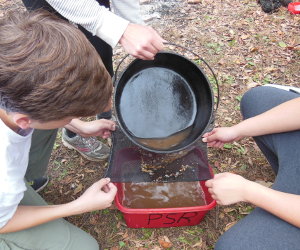

These scouts are carefully screening food bits out of waste water before disposing of it. Are your scouts well versed in Outdoor Ethics? How would they dispose of this water and the food bits?
I spent my weekend at scout camp on staff presenting a Leave No Trace Trainer course to 14 participants, 9 from one Venture Crew. What a fun time! We covered the seven LNT principles, each participant practicing teaching a topic out in the woods. We practiced the principles around camp, too.
I was responsible for supplying meals for the gang, so of course it included Dutch Oven Cooking. The scouts did a great job of minimizing fire impact, disposing of waste properly, and respecting wildlife, while I think I did good with the plan ahead and prepare bit.
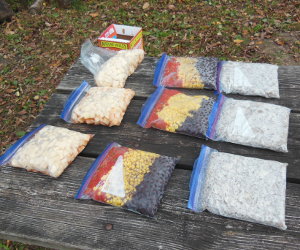

To demonstrate how planning ahead can help minimize impact, I repackaged all the meal ingredients into zip-loc baggies. I also cooked the meat at home. I froze the zip-locs so they all stayed cool in storage until we used them. Making a meal was easy - just grab the right bags, dump the contents into the dutch oven, and heat. The only garbage at camp was one large zip-loc full of all the other bags and the small amount of uneaten food from one meal.
I should have taken a picture of the 28 food cans that I emptied, cleaned, and recycled at home instead of bringing them outdoors.
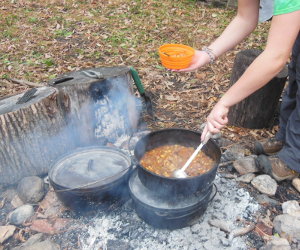

With a new group this large, it's challenging to know how much to make since some people may be picky eaters, or big eaters. The three dutch ovens of Cowboy Stew for lunch was scraped clean. The Frito Casserole for dinner virtually disappeared. And, it was a good thing I listened to advice and bought more cookies than I thought were needed. I bought a package of every kind of Oreo on the shelf, from Birthday Cake to Mint - I didn't realize just how many versions there are now. There's practically an Oreo Aisle at the store!
The McPancakes for Sunday breakfast could have gone better. They tasted great and were all eaten, but the pancake batter didn't behave very well. Oh well.
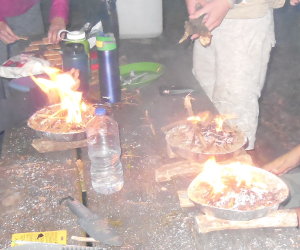

Some of the participant presentations were lots of fun. Various props brought as teaching aids included inflatable animals, burned garbage, a Powerpoint presentation, a potato, coloring pages, and pictures of recent non-LNT behavior from the internet.
Everyone got to practice making a mound fire of sorts - on sand, in a pie tin, resting on two branches above a picnic table. The small twiggy fires were enough to roast marshmallows for s'mores so I'd say there were successful.
And, of course, everyone dug catholes, too. That's a given for any LNT training.
Outdoor Ethics is an integral part of Scouting advancement now from Tigers through First Class. The Outdoor Ethics Guide position of responsibility can be very useful to help other scouts learn skills to minimize impact, but the entire pack/troop/crew culture needs to include respecting and caring for the outdoor world.
It isn't more work to minimize impact - it's just the way we do it. Is it how your Scouting unit does it, too?
| Leave Comment |
Posted: 9:34 10-18-2016 1308
Hiking-n-Cycling Safety Vest
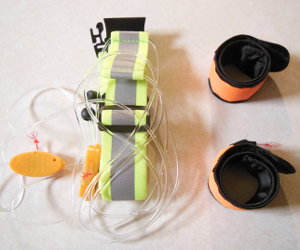

#ITLLEDVest
Here's something that anyone doing the Hiking or Cycling merit badges might find useful, especially if you're putting in miles on multi-use trails or along roads with traffic.
In the very dark night hours, cars have their headlights on and can see reflective safety gear fairly well. Many hikers, runners, and bicyclists wear neon green or orange reflective vests to be more visible, thinking that's good enough to be safe. But, there's an hour or so around sunrise and sunset when many drivers don't have their lights on and visibility is poor. Just reflective vests don't help at all at those times. That's why lighted safety gear is so much more valuable if you are out getting your exercise, covering miles for a merit badge requirement, walking the dog, or commuting around dusk or dawn and any time it's dark or dreary.
While walking on multi-use paths, as the daylight hours get shorter, I've had bicyclists fly past me with no lights on. It can be unsettling. I don't personally like wearing gaudy fluorescent colored clothes which unfortunately makes me more difficult to see. Fortunately, other options than a neon wardrobe are available.
This ITL led vest provides 360 degree visibility, not just straight ahead or behind like a headlamp or tail light. Reflective vests are only helpful if a car's or bike's light shines directly on it. With this LED vest, you are visible in complete darkness, from every direction, even to bikes not using any headlights.
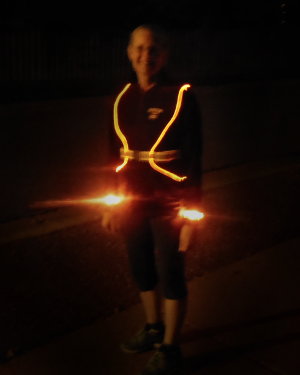

I got my wife to wear this cool safety gadget while I took the photos and video - I couldn't very well do both. But, I've also worn it on a few early morning and evening walks on the trail. The solid light is easy to see from a couple blocks away. To grab even more attention, turn on the LED strobe mode. The flashing lights can't be missed or ignored. And, if that isn't good enough, there's a fast flash mode for times you want everyone to watch you run past. I found that putting one light in flash mode and one in fast flash mode, it creates an irregular pattern of flashing that is the best attention getter.
The vest is made from an adjustable, elastic chest/waist band with plastic optic-fiber shoulder straps. The band is neon green fabric and a highly reflective strip. The shoulder straps are super lightweight plastic tubes to disperse the orange LED output. It does a terrific job of lighting up and turning heads. It's super easy to toss on, snap in place, and start running. Since it is so light, it is also very comfortable. The band can be adjusted from 26 inches up to 43 inches, fitting many body sizes.
The arm bands are a bonus. The vest itself does a great job, but adding the bands gives more color, more light, and more movement to increase visibility. Each band has 5 LEDs strung under a bright hunter's orange fabric for visibility during light or dark times. The LEDs have the same 3 modes as the vest. The bands slap onto your wrists and stay in place with no snaps or latches. They are long enough to be used on your bicep if you want them up higher. Hey, you could even wear one on your ankle and one on your arm on your right side, closest to traffic, to follow those safe hiking tips.
Turning the lights on, or changing their mode, is super simple. Each band and vest shoulder strap (4 total) has its own press button. Press to turn on, press to flash fast, press to flash normal, press to turn off. It would be nice if the vest buttons were on the front instead of in back, but they're still easy to use.
The vest uses 4 CR2032 batteries and each armband uses 2 CR2016 batteries. Purchasing those coin style batteries at your local store can get expensive, but I've bought them for my hiking headlight in quantities directly off the Internet for less than 25 cents each, and they work great. Replacing batteries in the vest is simple and easy, but the bands can be a bit tedious. You need to slide out the LED strip and battery holder and it tends to snag a bit on the orange fabric - no big deal, but annoying.
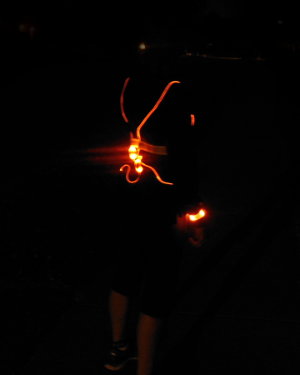

The vest weighs 4.8 ounces (136g) and each arm band weighs 1.0 ounce (28g) - and that includes the batteries. Under 7 ounces to stay safe and visible along the road or on the trail, day or night, walking or riding, seems like a very good investment to me.
Carrying this tiny item on my long hikes will help keep me safe when I have to walk the shoulder of roads. It's also useful during hunting season with its bright hunter orange and neon green fabric strips. Halloween also strikes me as another opportunity to ensure vehicles can see you easily.
I received this LED reflective vest for free in exchange for taking the time to try it out and share how well it worked for me.
Techy Junk: OK, I like to see how things work - sorry, it's just me. :-) While testing how to replace the batteries in an armband, I straightened it out and found that by straightening the very end of the band a bit past straight, it 'snaps' and stays flat! Then, the entire LED strip can be pushed out to replace the batteries. Once removed, I now have a very bright, 5-LED, light strip. It produces a lot of light so it's now also my 0.3 ounce, emergency back-up headlamp.
| Leave Comment |
Posted: 11:58 10-17-2016 1307
YAEP

 Yet Another Eagle Project was completed this past weekend in our community. This one was interesting, useful, and fun to help with.
Yet Another Eagle Project was completed this past weekend in our community. This one was interesting, useful, and fun to help with.Our elementary school just invested in an outdoor classroom this summer, spending tens of thousands of dollars on landscaping natural seating into a bowl-shaped area of the forest on the school property. This eagle project enhanced the usability of the area by designing, building, and installing four outdoor laboratory tables. The tables will be used by students for experiments about the environment, animal life, climate, and other nature studies topics.
The design is very sturdy and should hold up for many years of changing Minnesota seasons. The tables are set on two 4x4 posts sunk into the ground over 40 inches and rest at the correct height for small children. Each table is a box with hinged lid, creating a protect work area.
I took my orders from the Eagle candidate and spent my time digging holes with a post hole digger until he told me to stop. I think I did a pretty good job!
Another eagle project was done here earlier in the summer, also as part of this new outdoor classroom. It is the 'chalkboard' for the classroom - protected by small roof, locked protective plywood doors, and sturdy support structure.
I'm excited to see the new classroom in use this year. If you know of some Eagle candidates looking for projects, these outdoor classrooms are being set up in lots of schools now - might want to check locally. Or, I have many other ideas for Eagle Scout service projects.
| See 1 comment | Leave Comment |
Posted: 21:48 09-27-2016 1306
Ducttape and Paperclips

 Making things from old junk stretches the imagination of a boy and gives him freedom to invent, explore, and learn. I had access to lots of old equipment, building supplies, and junk while growing up on USFS ranger stations. I made some awesome things, from forts to kites to bombs - even electric motors.
Making things from old junk stretches the imagination of a boy and gives him freedom to invent, explore, and learn. I had access to lots of old equipment, building supplies, and junk while growing up on USFS ranger stations. I made some awesome things, from forts to kites to bombs - even electric motors.I believe my time spent watching MacGyver on TV helped, too. On that show, MacGyver could make anything with some ducttape, a couple paperclips, and no more than 10 minutes of effort. That's why I'm excited to hear a new version of the show is about to launch and BSA is holding a contest about it.
Some scout is going to win a trip to the MacGyver set in Atlanta. Ten others will win some backpack full of swag. But, every scout that enters will get a patch - not just a patch, but a collector's edition patch! OK, maybe you don't need YAP (Yet Another Patch) but, then again, maybe you do.
Anyway, a tip for 13+ year old scouts - when you enter the sweepstakes, choose the 13-17 age range to enter your postal address. If you're just 12, your parents need to get involved. I don't know why it's not open to younger scouts, but it's probably some legal internet child protection stuff.
Good luck, Scouts! Oh yeah, the sweepstakes ends October 30, so don't wait too long to enter.
Now, I just need to find 3 more paperclips and I'll get that hang glider finished!
| Leave Comment |
Posted: 16:26 09-21-2016 1305
Dutch Oven Results
Hey, thanks to the folks that took a chance at guessing which state has ordered the most copies of my signed dutch oven cookbook. A winner has been chosen!
I know I said that figuring out the books per capita would be too much work, but I was wrong. I did figure that out, and the results were interesting.
First, here's a map I made of orders from every state. As you can see, the top states are:
and the states with no orders are:
So, with that information, the winner was the only person that submitted a guess of California, and that was Benjamin W. - good job! I'll ship him his free cookbook as soon as he replies to my email. I'm pretty sure Benjamin went with the odds of California having the highest population, and that worked for him.
Four people guessed Utah which actually has the Dutch Oven as their official legislature-approved State Cooking Pot - imagine that! But, three people guessed Texas which has the Dutch Oven as their official State Cooking Implement - pretty much the same thing. (I never even knew states had official cooking items!) And, one person each guessed Hawaii and Rhode Island as having no orders.
I found it interesting to compare the raw numbers against the per capita numbers - that is, how many cookbook orders per million residents. I used the most recent census information online and came up with this:
If we used the Per Capita rating, the top states would be: Utah, Wisconsin, and Oregon, with California and Texas way down at 9 and 10.
So, from this detailed and scientific study (not), Utah really seems to be the Dutch Oven State. Being the curious type, I'll probably keep tracking cookbooks and post again in 6 months or a year. You can help your state rise in the standings. :-)
I know I said that figuring out the books per capita would be too much work, but I was wrong. I did figure that out, and the results were interesting.
First, here's a map I made of orders from every state. As you can see, the top states are:
- California
- Utah
- Texas
- Wisconsin
and the states with no orders are:
- Delaware
- Hawaii
- Rhode Island
- West Virginia
So, with that information, the winner was the only person that submitted a guess of California, and that was Benjamin W. - good job! I'll ship him his free cookbook as soon as he replies to my email. I'm pretty sure Benjamin went with the odds of California having the highest population, and that worked for him.
Four people guessed Utah which actually has the Dutch Oven as their official legislature-approved State Cooking Pot - imagine that! But, three people guessed Texas which has the Dutch Oven as their official State Cooking Implement - pretty much the same thing. (I never even knew states had official cooking items!) And, one person each guessed Hawaii and Rhode Island as having no orders.
I found it interesting to compare the raw numbers against the per capita numbers - that is, how many cookbook orders per million residents. I used the most recent census information online and came up with this:
| State | Pop | Raw | Capita |
| CA | 38.3 | 18 | .47 |
| UT | 2.9 | 16 | 5.52 |
| TX | 26.4 | 13 | .49 |
| WI | 5.7 | 12 | 2.11 |
| OR | 3.9 | 8 | 2.05 |
| MN | 5.4 | 8 | 1.48 |
| GA | 10.0 | 8 | .8 |
| IL | 12.9 | 7 | .54 |
| WA | 7.0 | 7 | 1.00 |
| PA | 12.8 | 7 | .55 |
If we used the Per Capita rating, the top states would be: Utah, Wisconsin, and Oregon, with California and Texas way down at 9 and 10.
So, from this detailed and scientific study (not), Utah really seems to be the Dutch Oven State. Being the curious type, I'll probably keep tracking cookbooks and post again in 6 months or a year. You can help your state rise in the standings. :-)
| Leave Comment |
Posted: 20:24 09-11-2016 1304
Dutch Oven Guess
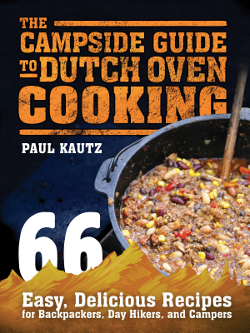
 Do you cook with dutch ovens? Which state has the highest dutch oven usage for cooking? Do scouts in Alabama use dutch ovens more than scouts in Wyoming?
Do you cook with dutch ovens? Which state has the highest dutch oven usage for cooking? Do scouts in Alabama use dutch ovens more than scouts in Wyoming?I've sent out 200 orders of my signed dutch oven cookbook this year, so I thought it would be fun to map the orders to states. This would give an idea of where dutch ovens are most popular. It would be too much work to figure out the orders per capita, so I'm just tracking the raw number of orders per state.
Before I post the map that shows which states are highest, and which states have no orders at all, I decided to give you all a chance to take a guess. I'll send a free signed copy of my cookbook to one person.
Enter your guess in the comments that says which state you think has the MOST ORDERS and one state that has NO ORDERS. There is one state with the most, but a few that have none. The winner will be the first to choose the top state and any of the bottom states. If no one does that, then it will be the first to choose the top state. If no one does that, then it will be whoever got closest to the top state. The guessing can commence Now and will end on Saturday.
My signed dutch oven cookbook could make an easy gift for that scout or volunteer that's looking for something new.
| See 10 comments | Leave Comment |
Posted: 16:06 09-05-2016 1303
R U A Winner?

 You won't be if you don't enter before midnight! Check out my contest page and take a shot to win one of three different prizes. It's free and spam-free, too.
You won't be if you don't enter before midnight! Check out my contest page and take a shot to win one of three different prizes. It's free and spam-free, too.Here are a few more contests you might want to enter...
- Scouting magazine gives away stuff. Visit their contest page to enter.
- Boys' Life has contests, too. You can see them all on their contest page - the worst you could do is get a patch.
Scout On and Good Luck
| See 1 comment | Leave Comment |
Posted: 15:02 08-31-2016 1302
10 Lightweight Tips
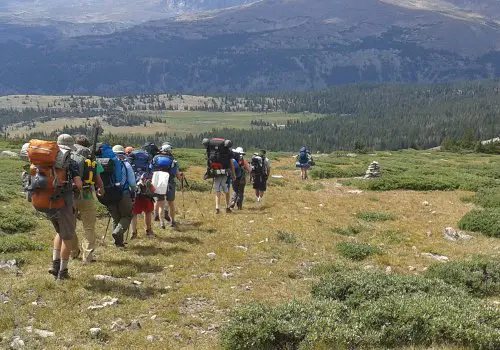

Here are 10 simple, safe, comfortable ways to cut 15 pounds or more from what you take on your next backpacking trip:
- Lose Nalgenes - (save 1lb) The Nalgene bottle is ubiquitous to backpacking and Scouting. There are at least 5 different styles available in my local Scout Shop. Each of them weigh at least 7 ounces so a scout carrying 2 has almost a pound of plastic. A 1-liter Platypus water bag weighs 0.9 ounces and costs about 75% of a Nalgene. But, a disposable soda or water bottle weighs about the same and costs <$1. The argument for Nalgene is "indestructibility" - I challenge you to break a disposable soda bottle. It's hard work! And, I did have a scout say to me, "See, it won't break" as he threw his Nalgene at a pile of rocks and then watched it shatter.
- Make Quilts - (save 2lb) Sleeping systems rely on loft for warmth. The part of a sleeping bag underneath you is compressed and has lost its loft, resulting in very little insulation. Your quilt or bedspread at home just lays on top of you, so use the same idea outdoors and cut out that compressed weight. It is a very easy sewing project to make a quilt from two layers of nylon and a layer or two of polyester insulating filler, for about $80 or $90. I've made two, one 2lb. and one 2.5lb - the difference is 1 or 2 layers of insulation. The 2.5lb quilt keeps me warm below freezing. A $25 sleeping bag can work down to that temp, but will weigh more like 4 or 5 lbs. A down quilt will weigh less, but cost a lot more.
- Make Backpacks - (save 4lb) Once you've cut the weight of what you're carrying from 50+lb down to <30lb, you can cut out the weight of your framed pack. My JanSport pack weighs 5lb and can carry an elephant, but I made my own 1lb pack for $40 and it can carry about 35lb. But, with my lighter packing, I never need more than 30lb, unless it's winter. Quest Outfitters have some very inexpensive plans and material kits so you can make packs for a group inexpensively.
- Carry Less Water - (save 3lb) I can't count the times I heard "Better fill up. We don't know when the next water stop will be." Water is the heaviest, and most important, item you will ever carry. Every liter you carry from one water source to another without drinking is 2.2lb of weight you didn't need. By using maps maps to plan water stops, you can carry just what is needed. The fear of running out of water is valid in arid areas, but the vast majority of places you'll hike will have plentiful water often. Drinking your fill at the water source, and then carrying 2 liters instead of 4 liters saves 4.5lb of excess weight.
- Water Filters - (save 1lb) Pump-action water filters, such as Katadyne and MSR, are obsolete. Sawyer Squeeze filters are light, fast, and they don't break. If every pair of scouts had one of these 3-ounce filters, you would have fast filtering, redundancy, and simplicity for a lower price. You fill a dirty water bag, screw on the filter, and squeeze, or hang and let gravity do the work. On the trail, you can just fill the bag at the source and then do the filtering whenever you want.
- Tarps & Nets - (save 4lb) Self-standing tents are easy and great for scouts. A silnylon tarp with a bug net hung underneath provides the same protection, better ventilation, and more flexibility at a greatly reduced weight. These lightweight shelters tend to cost more than tents, but DIY plans and materials are available. Quest Outfitters have a Bilgy Tarp Tent kit that is reasonable.
- That Darned Pocketknife - (save 4oz) I take a tiny 0.5oz folding knife with a very sharp blade on my long hikes. It has done everything I've needed. The everything but the kitchen sink pocketknife or multi-tool weighs a lot and is seldom used. If you really need that awl or saw, take it, but I've never needed them.
- Boots vs Shoes - (save 2lb) The discussion about wearing boots or shoes is usually very short. It's either "wear boots" or "wear shoes" with very little listening or changing of opinions. I used to wear boots, but have not since 2011. The most common reasons for wearing hiking boots that I've heard are "ankle support", "waterproof", and "durability". I invite you to search the 'net for more info, but I've worn light shoes with much more comfort, safety, and flexibility since changing my view on the topic.
- Food - (save 2lb) Most people take waaaaay too much food, and they take inefficient food. On a 3-day trek, taking 6 days of food just in case is very heavy. You already have 3 days of food just in case, so take just 1 extray day of food if you're really concerned with emergency needs. The types of food you choose also make you carry more weight for an equivalent amount of calories - ritz-style crackers have twice the calories as tortillas; olive oil is the most calorie-dense item you can carry and a few ounces of it in that dehydrated meal tastes good; nutella and peanut butter feel heavy but they have more calories by weight than many other foods. I've discovered that Aldi stores are good places to find high-calorie, low-cost backpacking foods.
- Take a Phone - (save 8oz) Cellphones are not just for phone calls, and you already know that. That 4oz pocket-sized electronic device is a camera, map, clock, alarm, info resource (first aid, skills, plants, ...), compass, gps, and much more - all while it is in airplane mode with no network connection. So, even in the backcountry, a handheld device is very useful and can save weight by leaving redundant items at home. Educating your group about how the devices should be used weighs nothing and takes only a little time.
With a little effort and $, you can cut that weight from ~50 pounds to ~30 pounds and still be comfortable, safe, and well-fed, but it's up to you.
| Leave Comment |
Posted: 18:28 08-19-2016 1294
Day 6 - Out of the Mountains
 A short, brisk hike down the mountain and we were back in civilization, taking showers in Buffalo, WY. We had the afternoon to explore the small town that just happened to be holding its "Crazy Days" event - basically a sidewalk saddle. My highlight was meeting this real, live, Wyoming cowboy selling lemonade with his little brother!
It was a super week with great weather having storms only at night, fun people, plenty of wildlife, and majestic views.
A short, brisk hike down the mountain and we were back in civilization, taking showers in Buffalo, WY. We had the afternoon to explore the small town that just happened to be holding its "Crazy Days" event - basically a sidewalk saddle. My highlight was meeting this real, live, Wyoming cowboy selling lemonade with his little brother!
It was a super week with great weather having storms only at night, fun people, plenty of wildlife, and majestic views. | Leave Comment |
Posted: 7:19 07-31-2016 1290
Previous PostsComments:
Feb 25, 2023 - Joe Patterson
Just out of curiosity, are the Rockwell paintings on exhibit anywhere
Mar 16, 2023 - Adam John
Great question Joe! Have you checked out the Norman Rockwell Museum in
Stockbridge MA? (nrm.org) There is also the Rockwell Museum in Corning
NY. (rockwellmuseum.org) I believe the latter has more art. Hope this
helps!
Jan 21, 2024 - Johnna Downing
The Scouting museum at Philmont, Cimmaron, NM hopefully has the ones that
used to hang at the museum in Irving, TX. Good luck. Johnna
Comment or Question about this page:
Scouting 2025 - Ask a Question - Add Content
Just for Fun: Socializing merit badge




This site is not officially associated with Scouting America
Find more Scouting Resources at www.BoyScoutTrail.com



Follow Me, Scouts
Recent Comments